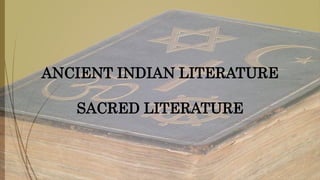
Ancient Indian Literatures - Sacred Literature
- 1. ANCIENT INDIAN LITERATURE SACRED LITERATURE
- 2. SACRED LITERATURES RELIGIOUS & MYTHOLOGICAL LITERATURES Hindu Literature Buddhist Literature Jain Literature
- 3. BRAHMANICAL LITERATURE Conveys religious beliefs & practices of Brahmins Provides information about the northern & north-western parts of India during 2nd and 1st millennium B.C. Consists of: Vedas Epics Puranas Vedangas Dharmasutras
- 4. Religious texts Shruti Smriti Vedas Samhitas Brahmanas Aranyakas Upanishads Sutra Ramayana Manusmriti PuranasMahabharata Bhagavad Gita (6th book)
- 5. VEDAS Contains “ETERNAL TRUTH”. Realised by rishis and revealed to them by Gods. Collection of hymns, prayers, sacrificial rituals, magic and nature poetry. Rig Veda, a collection of 1028 hymns in praise of gods and creation. Sama Veda, containing hymns, mostly from Rig Veda, to be chanted during sacrifices in which the juice of the Soma plant was offered. Yajur Veda, dealing with details of rituals and sacrifices. Atharva Veda, dealing with spells, magic and charms.
- 6. Parts of Vedas Samhitas Brahmanas Aryankas Upanishads Samhitas are the core collection of hymns, prayers and spells of the Vedas. They are often mistakenly referred to as the Vedas. Brahmanas are explanations of the Samhitas and give details of rituals and outcomes. Aryankas (forest books) give philosophical interpretations of the rituals. Upanishads, also called Vedantas, deal mostly with the philosophy of atman (soul) and brahman (ultimate spiritual reality of the universe).
- 7. EPICS The Ramayana (composed 5th century BC - 3rdcentury AD by Valmiki) and the Mahabharata(composed c. 400 BC - 400 AD by Vyasa) are the two great Sanskrit epics of ancient India which, straddling the expanse of centuries, still have a pervasive influence on the minds of millions of Indians.
- 8. RAMAYANA The Ramayana ("March of Rama") was composed around the 2nd century BCE, but likely drew on preexisting oral tradition. It tells the epic story of Rama, the 7th incarnation of the deity Vishnu. Written in high Sanskrit in the form of rhyming couplets. Contains seven sections (kandas): Bal Kanda - Rama's boyhood Ayodhya Kanda - Rama's life in Ayodhya until his banishment Aranya - Rama's life in the forest and his abduction by Ravana Kishkinda - Rama's stay at Kishkinda, the capital of his monkey ally Sugriva Sundara - Rama's journey to Sri Lanka Yuddha (or Lanka) - Rama's battle with Ravana, the recovery of Sita and their return to Ayodhya
- 9. MAHABHARATA At more than 100,000 verses (seven times the length of the Iliad and Odyssey combined), the Mahabharata may be the longest epic poem in the world. Authorship is traditionally attributed to the sage Vyasa; modern scholarship has established its development over several centuries ending in the first century AD. The central theme of the Mahabharata ("Great Tale of the Bharatas") is dharma, especially the dharma of kingship. The Mahabharata is most well known for the Bhagavad Gita(6TH BOOK), the single most popular Hindu text. The Bhagavad Gita ("The Song of the Lord") tells the story of King Pandu and his five sons and features a memorable appearance by Krishna, the popular incarnation of Vishnu.
- 10. VEDANGAS, PURANAS & DHARMASUTRAS The Vedangas (meaning 'limbs of the Vedas'), composed c. 600-200 BC, are supplementary texts for proper understanding and recitation of the Vedas. A group of Vedanga texts called Dharmasutras deal with dharma and how it should drive social norms, giving glimpses into the prevailing social practices. The Puranas (meaning 'old') deal with world creation, the genealogies of gods and rishis, and the royal dynasties. There are 18 main Puranas, including the Vishnu, Vayu, Matsya, Bhagvat and Agni Purana. Provide details on the ancient political history, referring to early dynasties like the Nandas, Mauryas and the Satavahanas. Provides information on the development of Hindu religious practices.
- 11. BUDDHIST LITERATURE o Important sources for the history of Buddhism and its royal patrons like Ashoka. o Uncover the aspects of political, social and economic conditions of the period.
- 12. TRIPITAKAS 3 Pitakas – The Three Baskets/Collections Written in Pali text Lays down the tenets and principles of Buddhism. 3 Pitakas: Sutta Pitaka, containing the sermons of the Buddha Vinaya Pitaka, which has rules for Buddhist monks and nuns Abhidhamma Pitaka, which contains a systematic arrangement of the teachings of the Sutta Pitaka.
- 13. The Jatakas, composed in the 3rd century BC - 2nd century AD, relate stories of the previous births of the Buddha. They have also served to give a glimpse of the social history of the period. Buddhaghosha, in the 5th century AD, wrote a commentary on the Tipitaka. The Sri Lankan Chronicles from the 5th century – the Dipavamsa and the Mahavamsa – deal with the Buddha's life, the Buddhist councils, emperor Ashoka and the kings of Sri Lanka.
- 14. JAIN LITERATURE Offers information on the history and doctrines of Jainism, as well as facets of the cultural life of the times. The sacred books of the Jains are collectively known as the Siddhanta or Agama, the most important of which are the twelve Angas. The early texts were in Prakrit. These books have been supposed to be compiled around 5th- 6th century AD. The Jain Puranas (Charitas) are the biographies of the Jain saints (thirthankaras)
- 15. THANK YOU !